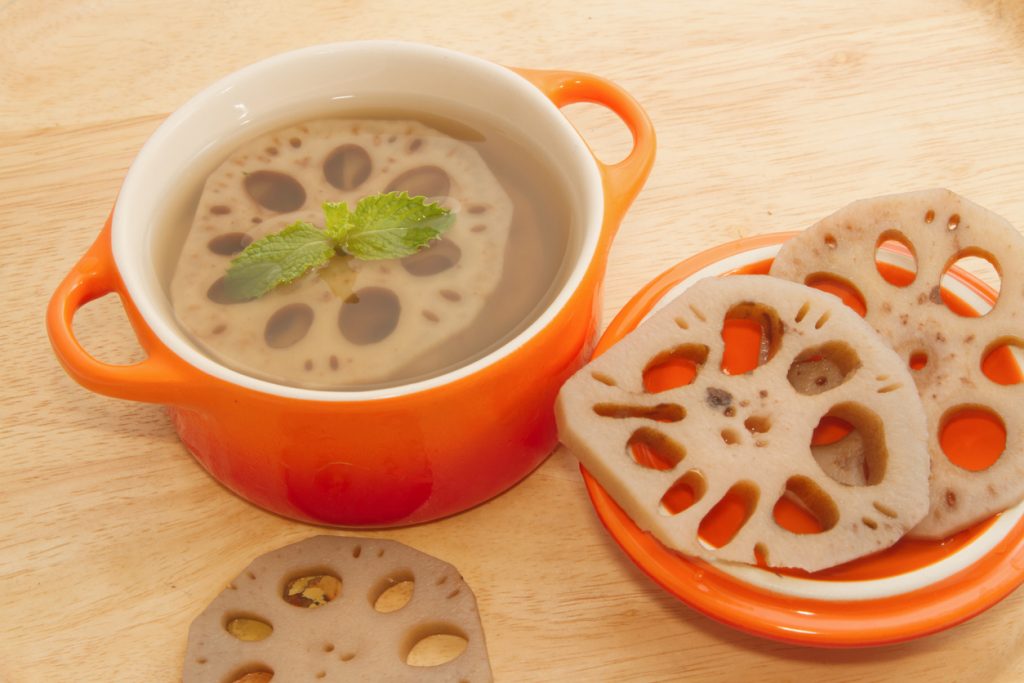Lotus Rhizome Node (Ou Jie)

What is Lotus Rhizome Node (Ou Jie)?
Lotus Rhizome Node (ou jie, 藕节) comes from Lotus, also known as Nelumbo nucifera, a perennial aquatic plant that is related to the water lily. Since ancient times, Lotus has been favoured by Chinese and Japanese culture as a symbol of purity and transcendence, where poets and artists often use it in their creations.
The node is a thick, sponge-like portion of the Lotus’s rhizome, it is cylindrical and segmented, and its tubular roots have air channels running along their lengths. The rhizomes are usually harvested in autumn and winter, where its nodes are removed, cleansed and dried under the sun. Used as a medicinal herb for centuries, Lotus Rhizome Node is also used culinary as a food ingredient.
In Traditional Chinese Medicine (TCM), Lotus Rhizome Node falls under the category of ‘Herbs that stop bleeding’. This category of herbs tend to have hemostatic properties, where it can help to stop various types of hemorrhages and ecchymosis. Neutral in nature, Lotus Rhizome Node does not affect the yin-yang balance in your body.
Sour and sweet in taste, Lotus Rhizome Node can aid digestion, restrain abnormal discharges of fluids from the body, such as diarrhea and heavy sweating. The herb can also slow down acute reactions, detoxify the body and has a tonic effect on the body by replenishing qi and blood. In particular, Lotus Rhizome Node targets the Liver, the Lungs and the stomach.
Functions and Benefits of Lotus Rhizome Node (Ou Jie)
Traditional Chinese Medicine (TCM) shows that Lotus Rhizome Node has the following health benefits.
Lotus Rhizome Node can stop bleeding, astringe leakage of blood and resolve Blood Stasis. Also, Lotus Rhizome Node is effective in removing excess Heat from the blood. Hence, this herb is often indicated for bleeding syndromes, especially for those caused by excess Heat in the Lungs or stomach, with hematemesis or hemoptysis. For example, Lotus Rhizome Node can be used to treat nosebleeds, bloody sputum, hematochezia and hematuria.
Lotus Rhizome Node is also often combined with other Heat-clearing herbs to address chronic bleeding syndromes. In addition, Lotus Rhizome Node can also reduce swelling caused by Blood Heat.
Modern studies have found that Lotus Rhizome Node may be able to prevent non-alcoholic fatty liver disease. Researchers found that Lotus roots could suppress inflammatory gene expression associated with the condition and protect the liver. Also, Lotus Rhizome Node may possess antioxidant and anti-inflammatory properties, which means that it may be able to fight signs of ageing, prevent chronic diseases and treat inflammatory conditions.
An animal study suggested that Lotus Rhizome Node may help to protect the stomach against stomach ulcers. Its potential antioxidant and anti-inflammatory properties can add to its gastro protective effects and speed up the recovery of the mucous layer of the stomach.
Other animal studies found that Lotus Rhizome Node extracts may reduce blood sugar levels, reduce nasal allergy symptoms, aid weight management, promote gut health and boost heart health. Also, Lotus Rhizome Node may help to reduce stress, irritability and headaches.

How to Use Lotus Rhizome Node (Ou Jie)
The recommended daily dosage of Lotus Rhizome Node is 10 – 30g, when consumed as a decoction. If fresh Lotus Rhizome Node is being used, larger doses of 30 – 60g may be prescribed.
Parched or charred Lotus Rhizome Node is believed to be more potent at stopping bleeding and reducing blood pressure levels than fresh Lotus Rhizome Node.
Whole, dried Lotus Rhizome Nodes may be found at many Asian markets, herbal shops and specialty stores. Lotus Rhizome Node is also available in other forms such as juice, pill, powder and capsules.
Cautions and Side Effects of Lotus Rhizome Node (Ou Jie)
Lotus rhizome node is considered to be a safe herb for consumption. The American Herbal Products Association has given it a class 1 rating, which means that it can be safely consumed when used appropriately.
However, Lotus Rhizome Node should not be used by individuals who are also consuming blood-thinning medications. As Lotus Rhizome Node may reduce blood pressure levels and blood sugar levels, consuming it together with blood-thinning medications may cause unwanted health issues.
We strongly encourage you to consult your healthcare provider before deciding to add Lotus Rhizome Node to your healthcare routine!
Summary
Here is a summary for Lotus Rhizome Node (Ou Jie):
- Herb name (Chinese): 藕节
- Herb name (Pin Yin): ǒu jiē
- Herb name (English): Lotus Rhizome Node
- Herb name (Botanical): Nodus Nelumbinis Rhizomatis
- Origin of species: Nelumbo nucifera Gaertn.
- Part(s) of herb used: Node or nodule
- Geo-specific habitat(s): Hunan, Hubei, Zhejiang, Jiangsu, Anhui
- Taste(s) & Properties: Sweet, astringent; Neutral; Administrates the Liver, Lung and Stomach Meridians
- Actions: Helps to stop bleeding and remove Blood Stasis
References
Lee, M. W., Kim, J. S., Cho, S. M., Kim, J. H., & Lee, J. S. (2001). Anti-diabetic constituent from the node of lotus rhizome (Nelumbo nucifera Gaertn). Natural Product Sciences, 7(4), 107-109. [Accessed on 14th February 2023]
Fatima, T., Iftikhar, F., & Hussain, S. Z. (2018). Ethno-medicinal and pharmacological activities of lotus rhizome. Journal of Pharmaceutical Innovation, 7(4), 238-241.[Accessed on 14th February 2023]
Shen-Miller, J. (2002). Sacred lotus, the long-living fruits of China Antique. Seed Science Research, 12(3), 131-143.[Accessed on 14th February 2023]
Share this article on
